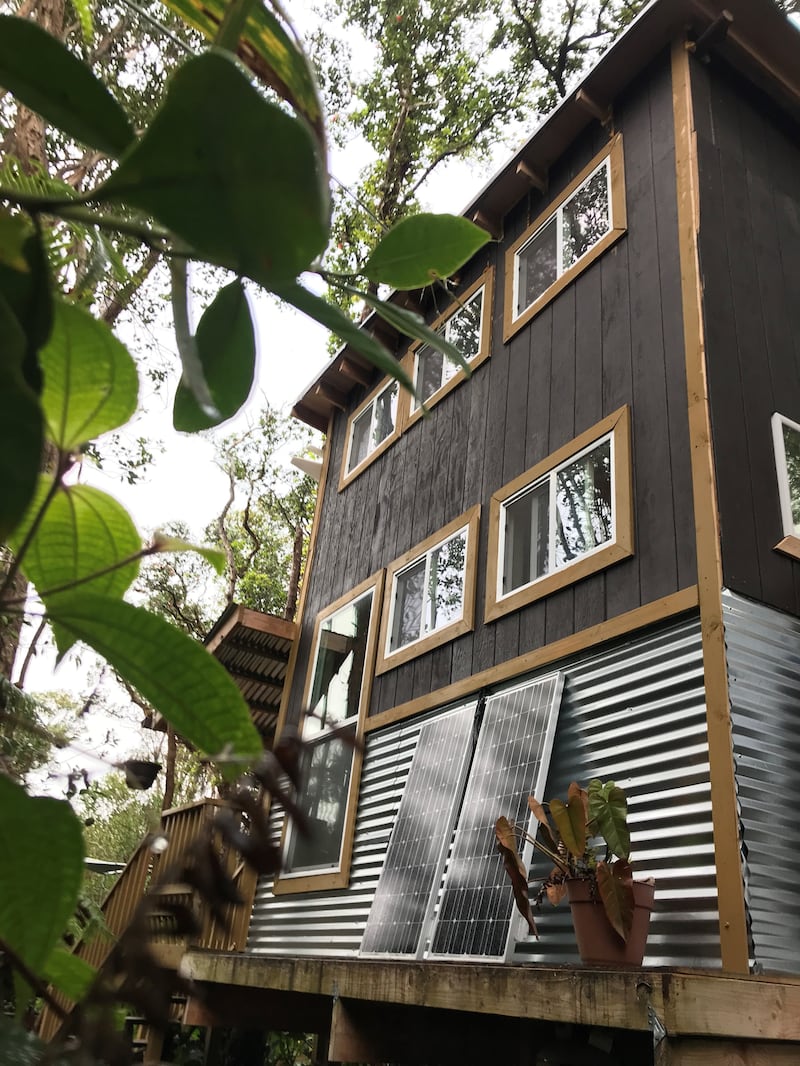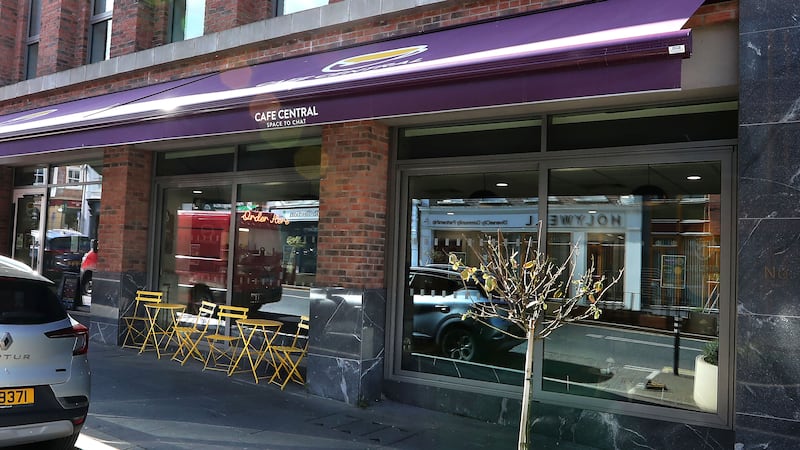A TikToker who lives off grid in a tree house in the middle of a Hawaiian jungle having bought the land using his monthly TikTok earnings has said he does not “miss a thing” from his previous life in the city.
Robert Breton, 35, ditched his life as a supermarket cashier in Northern California to live off grid as he wanted to “preserve nature as a whole” – he has been living remotely since 2011 when he travelled throughout the US in a van to find the perfect place to build a house.
In 2020, he decided to settle in Hawaii, and bought a quarter of an acre of land plus building materials for around 30,000 US dollars (£24,120).
It took Robert two years to build his 200sq-foot treehouse, and it is now a fully functioning home with a shower, toilet, bedroom and living area with hot water and double glazing 40 feet from the ground.
He grows and eats over half of his food from his greenhouse.

Robert spends just 25 dollars (£20.20) a month on wi-fi, and has no other bills – he occasionally buys extra food and gas, but more than half of his food comes from the produce he grows in his 30sq-foot greenhouse and the fruit trees that surround his tree house.
Robert shares his off grid lifestyle on TikTok, where he has more than 840,000 followers, to “encourage others to go back to basics and appreciate beautiful nature” and manages to make a living through his social media, as well as his supplement business, New Earth Organic.
He sees himself being off grid for the rest of his life and hopes one day to teach others about its benefits in person.
“The tree house is my living space and I have a bedroom, kitchen, living room and bathroom,” Robert said.

“It’s definitely liveable, beautiful and functional – I collect rainwater off the roof to drink and it flows into the kitchen and bathroom.
“I’ve also got solar panels for electricity, I use it for my kitchen and wi-fi to make TikToks – I don’t miss a thing from my old life really.”

He said: “When I was 14, I was picking plums and peaches on the local farm and my last job, in my late twenties, was working at Whole Foods, at the grocery store.”
He explained what initially appealed to him about having an off-grid lifestyle: “I wanted to preserve nature as a whole, I travelled to places like Alaska, which are just in beautiful nature, and that had always been the main priority.
“So having a lifestyle where I could just be immersed in nature, and have a very simple life has always been the goal.”

When he first told his loved ones about his decision, they were not very surprised, as Robert has always been a free spirit.
He said: “I’m definitely the black sheep of the family with little things like me being vegan for so long, or just being into health, detoxification and nutrition.

“Being off grid is something that I have always been interested in, but that doesn’t mean that they were accepting of it.”
Robert began living off grid in a van in 2011, and he spent the following nine years travelling up and down the US to find the perfect spot to settle.

He explained: “As far as location, I knew what place would be desirable for my interests, obviously, with me being vegan, having a lot of fruit.
“And detoxification is a big part of my lifestyle so just having access to clean foods and water, these are my major priorities.”

In 2020, Robert found a quarter of an acre of land for sale, in a jungle in Hawaii, which he purchased for 15,000 dollars (£12,043), and decided to build himself a permanent tree house – he made sure to build everything to meet safety regulations, but he did not need to purchase a permit to live there as he is in a “non-regulated agricultural zone”.
It took Robert two years to complete the 200sq-foot build, he explained: “I started in the very beginning with just my van with a cover in the driveway space I built and I lived in the van for years while I was building everything from scratch.
“Every pay check that would come in from making content would go into the house.

“So it was a matter of slowly building the structure, and then getting the foundation and the walls, and then the metal roof took many months.
“As soon as that was up, I could start living inside, so many meals and nights were spent outside just under the stars and the rain.”
Robert did not have any help, and did the entire build, and cleared the jungle’s land, without using any heavy machinery or a bulldozer. The total bill for his build was around 15,000 dollars (£12,000).

He said: “We’ve gone from raw jungle with thousands of trees, everything there had to be done by hand in order to carve out what’s there today – I wanted to preserve what was already there too.
“We now have edible fruit trees, raised bed gardens, greenhouses, it’s beautiful.”
Despite it being in the trees and 40 feet from the ground, Robert’s home looks like an average house with double glazed windows, a front door, a living room, a functioning kitchen, a bedroom and a bathroom.

He said: “It’s definitely one floor space, but I put in an upstairs loft for the bedroom, so it has 30-foot ceilings, and a downstairs kitchen and living space so that I can do office or online work.
“I have a hot shower and wi-fi by using battery-powered solar panels.
“As far as the bathroom and the shower are concerned, that’s connected behind the house in a cupboard space with a sink and a mirror.

“I built in a composting toilet and a septic system to make things a little more comfortable after a year.
“There’s even fruit that you can pick from the porch – all of this wouldn’t be possible in a normal residential landscape.”
Since being off grid, Robert has not missed anything in particular from his previous life, but he found adjusting to the lifestyle difficult at first.

He said: “I can’t get pizza delivered, or have anyone pick up my trash, or have my mail delivered to my house – that was a little weird at first.
“But I think it made me realise we all need to be more conscious of our trash – I compost everything I can and try to have little waste.
“I think it’s a responsibility for all of us as individuals to be conscious of our trash, the water that you should bring in yourself, and the food we grow.”

In terms of his monthly spending, Robert does not have a car or a mortgage, he just pays 25 dollars for unlimited wi-fi and occasionally buys gas for cooking, and food.
For food, Robert gets around half of his produce from his greenhouse and the surrounding trees.
He said: “I have a lot of sweet potatoes, kale and micro greens growing that are a major source of my calories that have a really high turnover rate in the greenhouse.

“I have supplements too, and I walk to the local town, which takes over an hour, to get other essentials like grains and quinoa.”
Robert’s only exception for his off-grid lifestyle is the fact he has wi-fi to run his TikTok and supplements business.
He began posting about his off-grid lifestyle on TikTok in 2019, and previously ran a YouTube channel for seven years – now his TikTok has more than 840,000 followers with several of his videos racking up more than three million views.

Looking to the future, Robert can see himself remaining off grid. He explained: “To me, being off grid, living and having nature and access to fresh fruit and vegetables right outside your door, and that local community is a big part of this new earth.
“I want to leave a legacy for my children and for there to be a new earth when everyone is back to basics, and it is less about consumerism.
“In the future, I want to continue doing this with a family and teach, learn and live a life of sustainability.”








